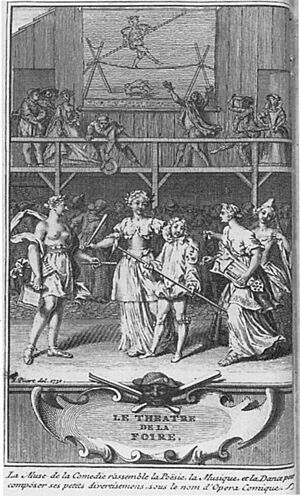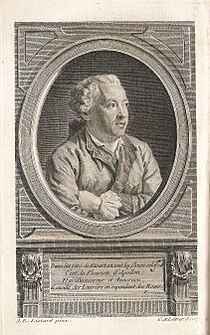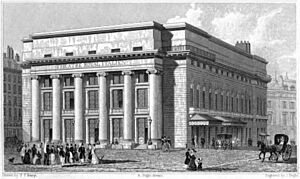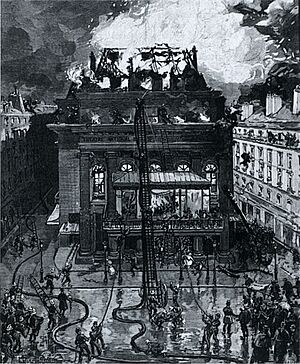Opéra-Comique facts for kids
|
Théâtre national de l'Opéra-Comique
|
|
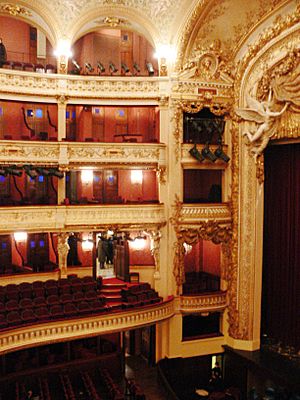
Interior of the Salle Favart, 2008
|
|
| Merged into | Comedie-Italienne (1762) Théâtre Feydeau (1801) |
|---|---|
| Formation | 1714 |
| Founder | Catherine Baron, Louis Gaultier de St. Edme |
| Founded at | Foire Saint-Germain |
| Type | Opera company |
| Location |
|
| Leader | Olivier Mantei |
|
Formerly called
|
|
The Opéra-Comique is a famous opera company in Paris, France. It started around 1714 at popular street fairs. In 1762, it joined with its main competitor, the Comédie-Italienne. For a while, it even used that name.
Today, its official name is the Théâtre national de l'Opéra-Comique. Its theatre, called the Salle Favart, can hold about 1,248 people. It is located in Paris, not far from another famous opera house, the Palais Garnier.
The Opéra-Comique has played a big part in the history of French opera. Its goal today is to explore its unique collection of works. It wants to share these operas with many people. Some of the most popular operas performed here include Carmen (over 2,500 times!), Manon, Lakmé, and Mignon.
Contents
How It Started
For hundreds of years, fun shows were part of the seasonal fairs in Paris. These shows included funny plays, acrobatics, and puppet shows. They also had music, like popular songs called vaudevilles. People from all walks of life enjoyed these shows on simple stages.
However, in 1672, King Louis XIV created the Royal Academy of Music, also known as the Opéra. This made it harder for fair troupes to use music in their shows.
In 1697, the Italian actors at the Hôtel de Bourgogne were banned from Paris. This happened because they made fun of the King's wife in a play. The fair theatres quickly started performing many of the Italian plays, including funny versions of operas.
Soon, the Opéra and the Comédie-Française saw the fair theatres as competition. They made rules even stricter. Fairground performers tried clever ways to get around the rules. They would show the actors' lines on big cards. Then, musicians would play a popular tune, and the audience would sing along while the actors stayed silent. Sometimes, the words were even shown on a large banner.
First Steps and Early Years
In 1713 and 1714, several fair troupes made new deals with the Opéra's managers. For a yearly fee, they could perform light comedies with songs and dances. They could also use sets and stage machines. They were even allowed to use the name "Opéra-Comique."
The first show officially called "Opéra-Comique" was Télémaque in 1715. It was a funny version of an opera. The words were by Alain-René Lesage, and the music was put together by Jean-Claude Gillier. In these early days, the person who wrote the words (the librettist) was more important than the composer. Charles-Simon Favart was a very important librettist for over forty years.
In 1743, a man named Jean Monnet took over the Opéra-Comique. He improved the theatre and brought together many talented artists. These included Favart, who also directed plays, and the famous stage designer François Boucher. However, the company became too successful, and the Opéra did not renew Monnet's contract in 1745.
Monnet returned in 1751 and remained director until 1757. During this time, Boucher designed a new theatre for the company in 1752. This new theatre was important because it allowed the company to perform even when the fair was not open. New works started to appear that had more music, like Italian operas. Composers like Antoine Dauvergne, Egidio Duni, François-André Danican Philidor, and Pierre-Alexandre Monsigny wrote music for the company.
From 1762 to 1807
On February 3, 1762, the Opéra-Comique joined with the Comédie-Italienne. It moved into the Hôtel de Bourgogne. The king officially renamed the company Opéra-Comique in 1780.
In 1783, the company moved again to the Salle Favart, which could seat about 1,100 people. This is where the current theatre stands today. Around this time, operas by André Grétry were very popular.
After 1791, many new theatres opened, leading to more competition. The Opéra-Comique merged with the Théâtre Feydeau in 1801. By 1807, Napoleon limited the number of theatres in Paris. The Opéra-Comique became one of the four main theatres.
The 19th Century
In the 19th century, "opéra comique" didn't always mean "funny." It was a broader term for operas that often included spoken dialogue between the songs. Important composers like Daniel Auber, Fromental Halévy, Hector Berlioz, and Georges Bizet wrote for the Opéra-Comique.
In 1840, the Opéra-Comique moved into the second Salle Favart. This new building was built on the site of the first theatre, which had burned down in 1838. The new house opened with a show called Le Pré aux clercs.
The Opéra-Comique premiered many important French works. These included Berlioz's The Damnation of Faust (1846), Thomas' Mignon (1866), and Bizet's Carmen (1875). Later in the century, the theatre also showed new pieces like Offenbach's Les Contes d'Hoffmann (1881), Delibes' Lakmé (1883), and Massenet's Manon (1884).
Sadly, a fire at the Salle Favart on May 25, 1887, caused the death of 84 people. The building was destroyed. The third Salle Favart was officially opened on December 7, 1898.
The 20th Century and Today
As the differences between "opéra" and "opéra comique" became less clear, the two main opera houses in Paris competed more. However, the Salle Favart continued to premiere new and exciting works. These included Debussy's Pelléas et Mélisande (1902) and Ravel's L'heure espagnole (1911). Between 1900 and 1950, the Opéra-Comique performed 401 works by 206 different composers.
In 1939, financial problems led to the Opéra-Comique joining with the Opéra. They became the 'Réunion des Théatres Lyriques Nationaux'. After World War II, many of the Opéra-Comique's best artists and works were moved to the Opéra.
In the 1950s, the Opéra-Comique found new energy. It brought back older shows and introduced new ones to attract audiences. However, in 1972, the Opéra-Comique company was closed. Its government funding was given to the Opéra.
Even though the company was disbanded, shows started to be staged at the theatre again in 1978. It performed both traditional and more adventurous works. In 1987, it hosted a major revival of the baroque opera Atys. The company regained its independence in 1990.
Today, the Opéra-Comique puts on 7 or 8 operas each season. It also offers concerts and exhibitions. Like many other opera houses, it broadcasts performances to cinemas across France and Europe. In 2015, the theatre closed for 18 months for major renovations. It reopened in 2017 with a performance of Marais's Alcione.
Theatres Used by the Opéra-Comique
| Theatre | Dates used | Notes |
|---|---|---|
| at fairs, seasonally | 1714 – 1762 | Performed at the St Germain and St Laurent fairs. |
| Hôtel de Bourgogne | 3 February 1762 – 4 April 1783 | Merged into Comédie-Italienne. |
| Salle Favart (1st) | 28 April 1783 – 20 July 1801 | First Salle Favart was destroyed by fire in 1838. |
| Salle Feydeau | 16 September 1801 – 22 July 1804 | Merged with Théâtre Feydeau. |
| Salle Favart (1st) | 23 July 1804 – 4 July 1805 | Except for a short time at Salle Olympique. |
| Salle Feydeau | 2 September 1805 – 12 April 1829 | |
| Salle Ventadour | 20 April 1829 – 22 March 1832 | Built for the Opéra-Comique. |
| Salle de la Bourse | 24 September 1832 – 30 April 1840 | Also known as the Théâtre des Nouveautés. |
| Salle Favart (2nd) | 16 May 1840 – 25 May 1887 | Except for a short time at Salle Ventadour. Second Salle Favart destroyed by fire in 1887. |
| Salle du Théâtre Lyrique | 15 October 1887 – 30 June 1898 | Located at Place du Châtelet. |
| Théatre du Château-d'Eau | 26 October – 30 November 1898 | |
| Salle Favart (3rd) | 7 December 1898 – present | Declared a historic monument in 1977. |
Famous Premieres
| Date | Composer | Work | Theatre |
|---|---|---|---|
| 30 July 1753 | Antoine Dauvergne | Les troqueurs | Foire Saint-Laurent |
| 26 July 1757 | Egidio Duni | Le peintre amoureux de son modèle | Foire Saint-Laurent |
| 9 March 1759 | François-André Danican Philidor | Blaise le savetier | Foire Saint-Germain |
| 22 August 1761 | François-André Danican Philidor | Le maréchal ferrant | Foire Saint-Laurent |
| 14 September 1761 | Pierre-Alexandre Monsigny | On ne s'avise jamais de tout | Foire Saint-Laurent |
| 22 November 1762 | Pierre-Alexandre Monsigny | Le roi et le fermier | Hôtel de Bourgogne |
| 27 February 1765 | François-André Danican Philidor | Tom Jones | Hôtel de Bourgogne |
| 20 August 1768 | André Grétry | Le Huron | Hôtel de Bourgogne |
| 5 January 1769 | André Grétry | Lucile | Hôtel de Bourgogne |
| 6 March 1769 | Pierre-Alexandre Monsigny | Le déserteur | Hôtel de Bourgogne |
| 20 September 1769 | André Grétry | Le tableau parlant | Hôtel de Bourgogne |
| 16 December 1771 | André Grétry | Zémire et Azor | Hôtel de Bourgogne |
| 12 June 1776 | André Grétry | Les mariages samnites | Hôtel de Bourgogne |
| 3 January 1780 | André Grétry | Aucassin et Nicolette | Hôtel de Bourgogne |
| 21 October 1784 | André Grétry | Richard Coeur-de-lion | Salle Favart (1st) |
| 4 August 1785 | Nicolas Dalayrac | L'amant statue | Salle Favart (1st) |
| 15 May 1786 | Nicolas Dalayrac | Nina, ou La folle par amour | Salle Favart (1st) |
| 14 January 1789 | Nicolas Dalayrac | Les deux petits savoyards | Salle Favart (1st) |
| 4 September 1790 | Étienne Méhul | Euphrosine | Salle Favart (1st) |
| 15 January 1791 | Rodolphe Kreutzer | Paul et Virginie | Salle Favart (1st) |
| 9 April 1791 | André Grétry | Guillaume Tell | Salle Favart (1st) |
| 3 May 1792 | Étienne Méhul | Stratonice | Salle Favart (1st) |
| 6 May 1794 | Étienne Méhul | Mélidore et Phrosine | Salle Favart (1st) |
| 11 October 1799 | Étienne Méhul | Ariodant | Salle Favart (1st) |
| 23 October 1800 | Nicolas Dalayrac | Maison à vendre | Salle Favart (1st) |
| 16 September 1801 | Adrien Boieldieu | Le calife de Bagdad | Salle Favart (1st) |
| 17 May 1806 | Étienne Méhul | Uthal | Salle Feydeau |
| 17 February 1807 | Étienne Méhul | Joseph | Salle Feydeau |
| 9 May 1807 | Nicolas Isouard | Les rendez-vous bourgeois | Salle Feydeau |
| 22 February 1810 | Nicolas Isouard | Cendrillon | Salle Feydeau |
| 4 April 1812 | Adrien Boieldieu | Jean de Paris | Salle Feydeau |
| 29 March 1821 | Ferdinando Paer | Le maître de chapelle | Salle Feydeau |
| 10 December 1825 | Adrien Boieldieu | La dame blanche | Salle Feydeau |
| 28 January 1830 | Daniel Auber | Fra Diavolo | Salle Ventadour |
| 3 May 1831 | Ferdinand Hérold | Zampa | Salle Ventadour |
| 15 December 1832 | Ferdinand Hérold | Le Pré aux clercs | Salle de la Bourse |
| 25 September 1834 | Adolphe Adam | Le chalet | Salle de la Bourse |
| 16 December 1835 | Fromental Halévy | L'éclair | Salle de la Bourse |
| 13 October 1836 | Adolphe Adam | Le postillon de Lonjumeau | Salle de la Bourse |
| 2 December 1837 | Daniel Auber | Le domino noir | Salle de la Bourse |
| 11 February 1840 | Gaetano Donizetti | La fille du régiment | Salle de la Bourse |
| 6 March 1841 | Daniel Auber | Les diamants de la couronne | Salle Favart (2nd) |
| 6 December 1846 | Hector Berlioz | La damnation de Faust | Salle Favart (2nd) |
| 28 December 1847 | Daniel Auber | Haydée | Salle Favart (2nd) |
| 3 January 1849 | Ambroise Thomas | Le caïd | Salle Favart (2nd) |
| 18 May 1849 | Adolphe Adam | Le toréador | Salle Favart (2nd) |
| 20 April 1850 | Ambroise Thomas | Le songe d'une nuit d'été | Salle Favart (2nd) |
| 4 February 1853 | Victor Massé | Les noces de Jeannette | Salle Favart (2nd) |
| 16 February 1854 | Giacomo Meyerbeer | L'étoile du nord | Salle Favart (2nd) |
| 23 February 1856 | Daniel Auber | Manon Lescaut | Salle Favart (2nd) |
| 4 April 1859 | Giacomo Meyerbeer | Le pardon de Ploërmel | Salle Favart (2nd) |
| 12 May 1862 | Félicien David | Lalla-Roukh | Salle Favart (2nd) |
| 17 November 1866 | Ambroise Thomas | Mignon | Salle Favart (2nd) |
| 23 November 1867 | Jacques Offenbach | Robinson Crusoé | Salle Favart (2nd) |
| 22 May 1872 | Georges Bizet | Djamileh | Salle Favart (2nd) |
| 12 June 1872 | Camille Saint-Saëns | La princesse jaune | Salle Favart (2nd) |
| 24 May 1873 | Léo Delibes | Le roi l'a dit | Salle Favart (2nd) |
| 3 March 1875 | Georges Bizet | Carmen | Salle Favart (2nd) |
| 10 February 1881 | Jacques Offenbach | Les contes d'Hoffmann | Salle Favart (2nd) |
| 14 April 1883 | Léo Delibes | Lakmé | Salle Favart (2nd) |
| 19 January 1884 | Jules Massenet | Manon | Salle Favart (2nd) |
| 18 May 1887 | Emmanuel Chabrier | Le roi malgré lui | Salle Favart (2nd) |
| 7 May 1888 | Édouard Lalo | Le roi d'Ys | Théâtre Lyrique |
| 15 May 1889 | Jules Massenet | Esclarmonde | Théâtre Lyrique |
| 30 May 1890 | André Messager | La Basoche | Théâtre Lyrique |
| 18 June 1891 | Alfred Bruneau | Le rêve | Théâtre Lyrique |
| 23 November 1893 | Alfred Bruneau | L'attaque du moulin | Théâtre Lyrique |
| 24 May 1899 | Jules Massenet | Cendrillon | Salle Favart (3rd) |
| 2 February 1900 | Gustave Charpentier | Louise | Salle Favart (3rd) |
| 20 November 1901 | Jules Massenet | Grisélidis | Salle Favart (3rd) |
| 30 April 1902 | Claude Debussy | Pelléas et Mélisande | Salle Favart (3rd) |
| 10 May 1907 | Paul Dukas | Ariane et Barbe-bleue | Salle Favart (3rd) |
| 5 June 1907 | André Messager | Fortunio | Salle Favart (3rd) |
| 30 November 1910 | Ernest Bloch | Macbeth | Salle Favart (3rd) |
| 19 May 1911 | Maurice Ravel | L'heure espagnole | Salle Favart (3rd) |
| 15 May 1914 | Henri Rabaud | Mârouf, savetier du Caire | Salle Favart (3rd) |
| 25 December 1915 | Xavier Leroux | Les cadeaux de Noël | Salle Favart (3rd) |
| 16 December 1927 | Darius Milhaud | Le pauvre matelot | Salle Favart (3rd) |
| 3 June 1947 | Francis Poulenc | Les mamelles de Tirésias | Salle Favart (3rd) |
| 6 February 1959 | Francis Poulenc | La voix humaine | Salle Favart (3rd) |
Directors of the Opéra-Comique
|
|
|
Music Directors
|
|
Images for kids
See also
 In Spanish: Teatro Nacional de la Opéra-Comique para niños
In Spanish: Teatro Nacional de la Opéra-Comique para niños


